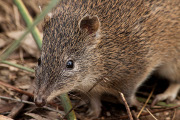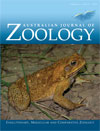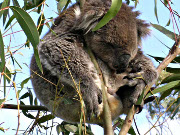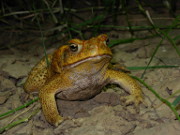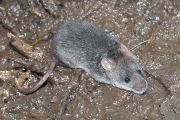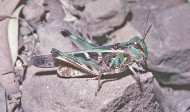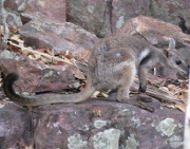Australian Journal of Zoology
Volume 62
Number 5 2014
The southern brown bandicoot, Isoodon obesulus obesulus, has experienced a dramatic decline in Australia and is listed as nationally endangered. Using genetic analyses of the subspecies from South Australia and south-western Victoria, we show this subspecies comprises multiple evolutionarily significant units and management units that are important for its conservation management.
Photo by Casey O’Brien.
This study examined the gross and histological structure of thyroid glands in South Australian koalas. It was found that thyroid glands of adult koalas were atypical compared with those of juveniles and characterised by large colloidal macrofollicles lined by flattened epithelium. This age-dependent change may be associated with the low metabolic rate of this species.
Photo by Natasha Speight.
There is little recognition that cane toads are spreading into south-western Queensland. Utilising local knowledge, a limited survey was undertaken within the Cooper Creek catchment, finding toads as far south as Jundah. We conclude that there is no reason why cane toads cannot penetrate further down the Cooper Creek, threatening wetlands in north-eastern South Australia.
Photo by David Peacock.
Alien redfin perch and native golden perch are predatory fishes. We identified dietary differences during drought that imply resource partitioning occurred between the perches, whereas the promotion of pelagic prey fishes during flooding apparently facilitated resource sharing. The findings suggest redfin perch can directly compete with native piscivores for prey.
Photo by Scotte Wedderburn.
We examined historical and contemporary influences on the genetic structure of the threatened water mouse, Xeromys myoides, across its disjunct Australian distribution. We found very low genetic diversity, suggesting that the species consists of a single evolutionarily significant unit and has undergone a recent range expansion in Australia.
Photo by Ian Gynther.
Free-ranging Gastrimargus muscicus (yellow-winged grasshopper) were captured in the field to determine effects of feeding on salivary gland function. Salivary glands increased in size with food in the crop, and the staining pattern for serotonin within the salivary glands suggested that food consumption stimulated gland activity.
Photo courtesy of Dr David Rentz.
Morphological and genetic data indicate that the short-eared rock-wallaby Petrogale brachyotis represents at least two separate species: P. brachyotis (sensu stricto) from the Kimberley and western Northern Territory (NT), and P. wilkinsi from the northern and eastern NT. Additionally, P. brachyotis (sensu stricto) can be separated into two subspecies.
Photo by Emily Miller.
